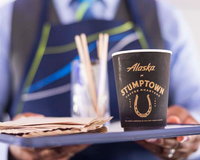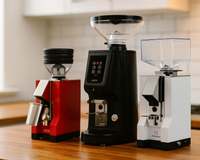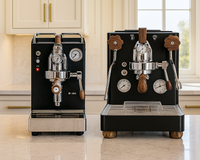How to Choose the Right Espresso Grinder for Your Machine

Why the Grinder Matters (Even More Than the Machine)
Many espresso lovers obsess over which machine to buy—dual boiler or heat exchanger, paddle vs. PID—but overlook the most important piece of the puzzle: the grinder.
A great grinder ensures consistent particle size distribution, minimal clumping, and excellent control over your grind size, which ultimately determines your extraction rate and flavor clarity. Even a high-end espresso machine can’t compensate for a bad grind.
How an Espresso Grinder Affects Flavor
- Grind Consistency: Reduces channeling and ensures even extraction.
- Clump Reduction: Prevents uneven puck density and bitter/sour flavors.
- Precision: Micro-adjustments are essential for dialing in espresso shots.
- Retention: Lower retention = fewer stale grinds in your shot.

Burr Types: Flat vs. Conical
Flat Burr Grinders
Flat burrs create a highly uniform grind. This leads to excellent flavor separation and brightness, which is ideal for lighter roast espresso. However, they can generate more heat and may be slightly louder.
Recommended for: Single origin light roasts, clarity lovers, high-end machines like the Lelit Bianca V3.
Conical Burr Grinders
Conical burrs create a bimodal particle distribution. While less uniform, they produce richer, more traditional espresso with heavy body and crema. They run quieter and cooler, making them great for home setups.
Recommended for: Medium to dark roasts, traditional flavor profiles, machines like the Lelit Mara X.
Single Dosing vs Hopper Grinders

Single Dosing
- Grind only what you need for one shot
- Lower retention and improved freshness
- Manual workflow (RDT, bellows, etc.)
Great for: Coffee enthusiasts who switch beans often, like DF64 or DF83 users.
Hopper Grinders
- Designed for volume and speed
- Store beans in the hopper for multiple shots
- Easier workflow but higher retention
Great for: Homes or offices with consistent daily usage—think Eureka Mignon or Atom series.
Burr Size and Motor Power
Larger burrs (64mm–83mm) provide faster grinding and better particle uniformity. Smaller burrs (50mm–55mm) are quieter and more compact, but less efficient for back-to-back shots.
Recommended:
- Minimum 250W motor for espresso
- Flat burrs: 64mm or larger for high-end results
- Conical burrs: 40mm+ is sufficient for most home use
Pairing Grinders with Espresso Machines
Lelit Bianca V3
This dual boiler with flow control deserves a grinder that can deliver extremely consistent results. Pressure profiling with the paddle means your grind needs to be dialed-in precisely.
Lelit Mara X / Victoria
Heat exchanger or compact machines benefit from grinders that are responsive and easy to dial in. You don’t need to overspend, but you’ll want solid consistency.
LUCCA A53 Mini / Profitec Pro 700
These prosumer dual boilers pair well with commercial-grade grinders.
- 🟢 Mazzer Mini E
- 🟢 Eureka Olympus 75
Grinders by Budget
Entry-Level (under $500)
- Turin DF64 Gen 2 – best value flat burr
- Eureka Mignon Silenzio – quiet and compact
- Baratza Sette 270 – great workflow, fast grind
Mid-Range ($500–$900)
- DF83 – single dose beast with 83mm burrs
- Eureka Specialita or Oro XL – fantastic espresso burr geometry
- Baratza Vario+ – solid and reliable
Premium ($1,000+)
-
Acaia Orbit – precision and modern design
- Eureka Atom 75 W – low retention, stepless adjustment
Maintaining Your Grinder
Good maintenance is crucial for taste and grinder longevity.
- Brush or vacuum burr chamber weekly
- Use grindz tablets or air blaster for monthly cleanups
- Avoid oily beans—they clog burrs
- Replace burrs every 1,200 lbs (steel), 700 lbs (ceramic)
Common Grinder Mistakes to Avoid
- ❌ Using an all-purpose grinder (you need espresso-specific)
- ❌ Ignoring retention — stale grounds ruin flavor
- ❌ Expecting “espresso” settings from entry-level brew grinders
- ❌ Skipping calibration after burr changes
FAQs
Is a grinder more important than the espresso machine?
Yes. A premium grinder paired with a decent machine will outperform a top-tier machine paired with a low-end grinder.
Can I use a brew grinder for espresso?
Most brew grinders can’t grind fine enough for espresso and lack the micro-adjustments needed. Use a dedicated espresso grinder.
Is flat or conical better?
Flat burrs offer better clarity; conicals produce more body. Neither is “better” — it depends on your preference and roast type.
What’s best for light roasts?
Flat burr grinders with large burrs. Light roasts require precise grinding and consistent extraction—DF83 or Atom 75 W are excellent picks.
Final Thoughts
Your grinder is the heart of your espresso setup. It controls every variable that matters: dose, grind size, consistency, and flavor clarity. Whether you’re running a Lelit Bianca with paddle pressure profiling or a Mara X with PID control, your grinder should match the precision and quality of your machine.















